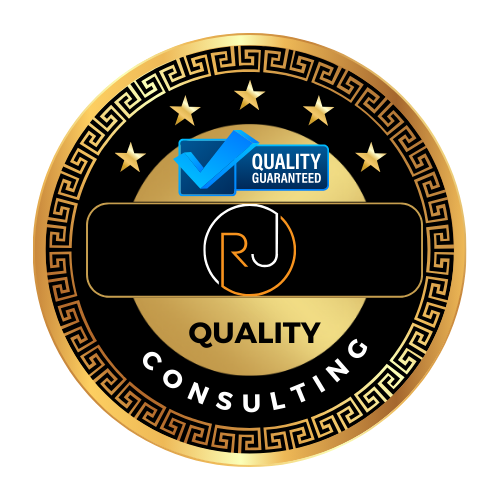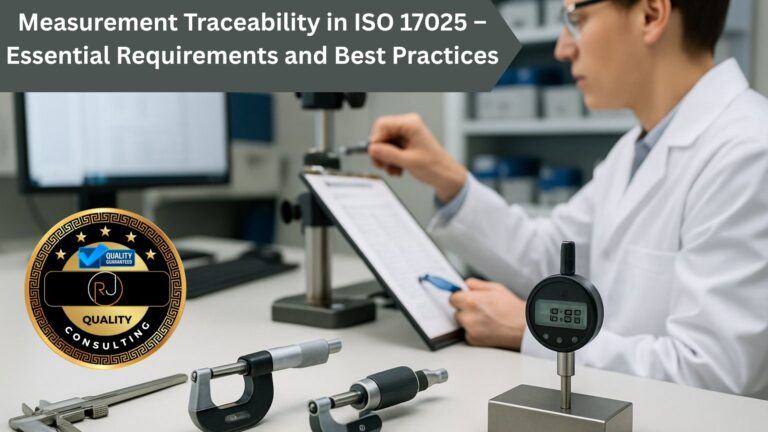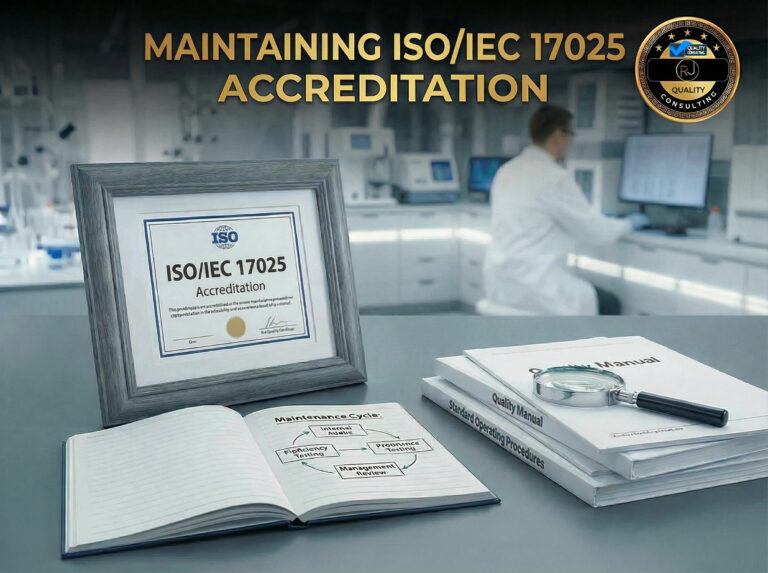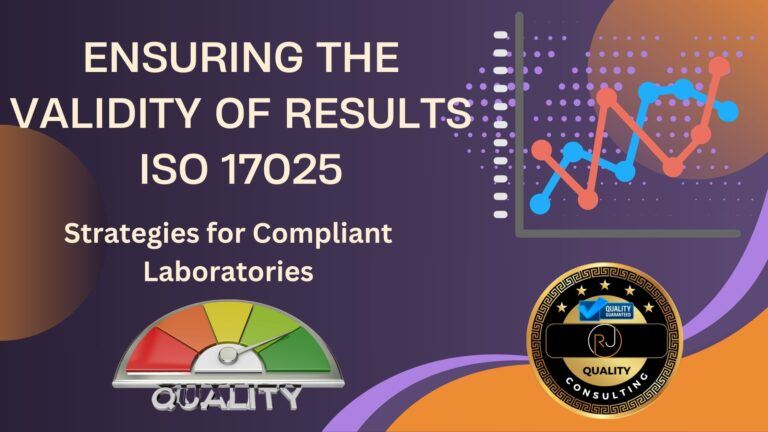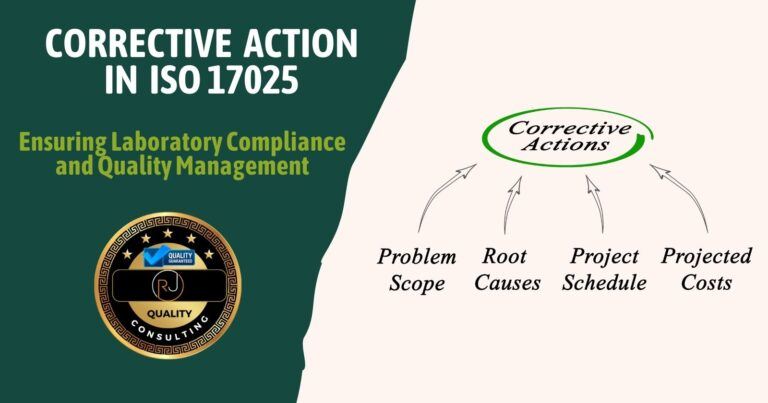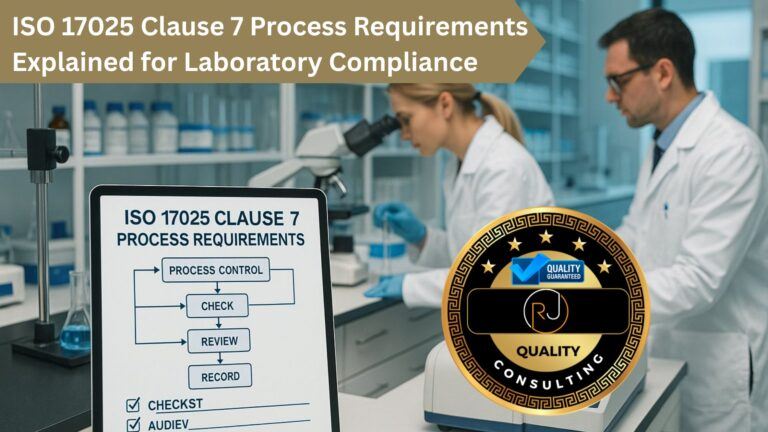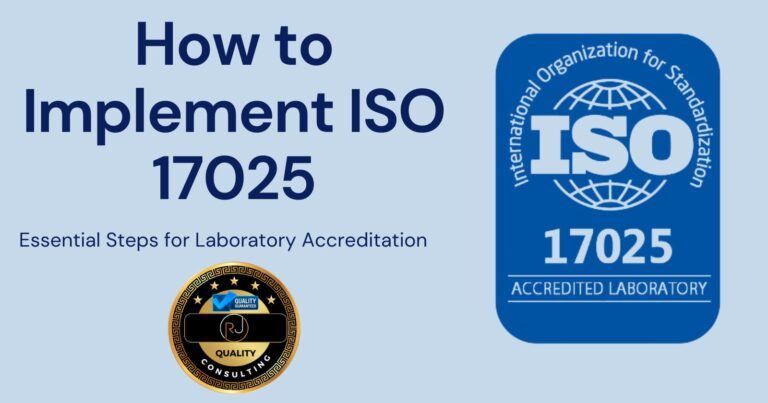ISO 17025 Method Validation: Ensuring Laboratory Competence and Reliability
In the realm of laboratory testing and calibration, ISO/IEC 17025 is a paramount standard that specifies the general requirements for the competence to carry out tests and calibrations, including sampling. It covers testing and calibration performed using standard methods, non-standard methods, and laboratory-developed methods. ISO 17025 Method validation is a critical component of this standard, ensuring that laboratories can achieve consistent, reliable, and accurate test results.
If you’re getting ready for ISO/IEC 17025 accreditation—or tightening up your current system—this short video walks through Clause 7.2 method validation step-by-step. You’ll see when to validate vs. verify, a practical 7-step workflow, the key performance characteristics (accuracy, precision, linearity, LOD/LOQ, robustness), and the documentation assessors expect. Watch it first, then use the checklist and templates linked below the video to put it into practice.
Method validation under ISO/IEC 17025 involves a series of procedures that laboratories must perform to confirm that a particular method is suitable for its intended use. This not only enhances the reliability of the results generated but also reinforces the laboratory’s accreditation status. By validating methods, laboratories demonstrate that they can produce data that are precise, accurate, and repeatable, meeting the criteria established by the standard.
Key Takeaways
ISO/IEC 17025 Implementation Masterclass
Complete documentation + step-by-step training to get your lab accreditation-ready with confidence.
What you get (features)
- Customizable Quality Manual aligned to ISO/IEC 17025
- All required policies & procedures with matching forms/templates
- 7 training modules (Clauses 4–8, internal audit & management review)
- 20-question quiz + certificate of completion
- Clear instructions on tailoring documents to your lab
Why it matters (benefits)
- Implement faster with proven, audit-ready templates
- Train your team consistently and reduce nonconformities
- Show competence to assessors with documented training & certificate
- Confidently prepare for internal & external audits
- Move from “paper compliance” to a working quality system
- ISO/IEC 17025 is essential for laboratory competence in testing and calibration.
- Method validation is key to reliable, consistent, and accurate laboratory results.
- Validating methods enhances a laboratory’s credibility and accreditation status.
Understanding ISO 17025 Method Validation
Method validation under ISO/IEC 17025 ensures your laboratory’s testing processes meet the required standards of quality and performance. Watch the video below from the very reputable ISO 17025 accreditation body, PJLA, to learn more about the ISO/IEC 17025 requirements concerning ISO 17025 method validation as detailed in section 7.2, Selection, Verification, and Validation of Methods of the ISO/IEC 17025:2017 standard.
Definition of Method Validation in ISO 17025
Method Validation is a process documented by ISO/IEC 17025 that confirms your testing or calibration methods are suitable for their intended purpose. It requires examining and providing objective evidence that the specific requirements of your methods are fulfilled.
- Specificity: The method must unequivocally identify the analyte in the presence of other substances.
- Approval: The validated method should be approved and signed off by responsible personnel.
- Documentation: Proper validation requires maintaining comprehensive records as part of your method documentation.
Purpose and Objectives of Method Validation
The purpose of method validation under ISO/IEC 17025 is to ensure consistent, reliable, and accurate testing outcomes in your laboratory.
Objectives include:
- Quality Assurance: To ascertain the quality of the testing or calibration method, making sure it is fit for the intended use.
- Performance Verification: Confirming the method performs as expected over a range of conditions.
- Accreditation Compliance: Validated methods are a prerequisite for gaining and maintaining ISO/IEC 17025 accreditation, demonstrating your lab’s capability and competence.
The ISO 17025 Method Validation Process

Method validation under ISO 17025 is a critical procedure that ensures your laboratory’s testing methods meet the required standards for accuracy and reliability. This process verifies that methods are suitable for their intended analytical use.
Steps in Method Validation Process
- Definition of the Requirements: You initially need to identify the specific performance parameters and the scope of the methods to be validated, aligning them with your laboratory’s needs.
- Preparation of a Validation Protocol: Prepare a document outlining how validation will be performed, including objectives, responsibilities, procedures, and acceptance criteria.
- Execution of Validation Plan: Carry out the validation according to the protocol, meticulously documenting all activities.
- Performance Parameters Assessment: Evaluate crucial performance parameters such as selectivity, accuracy, precision, linearity, range, detection limit, and robustness.
- Analysis of Data: Analyze the data generated and confirm that it meets pre-defined criteria.
- Preparation of the Validation Report: Compile all findings into a comprehensive report which will become part of your quality documentation.
- Implementation of the Method: Upon successful validation, implement the method as a standard procedure in your laboratory.
Selecting Appropriate Validation Methods
- Selection Based on Method Type: If you are using a standard method, your selection for validation depends on whether it’s already been validated by other organizations. If so, your focus will be on verification rather than full validation.
- Adjustments for Non-standard and Laboratory-developed Methods: For non-standard or in-house methods, choose a validation approach that comprehensively assesses whether the method fulfills all performance requirements and is fit for the intended purpose.
- Consideration of Method Modifications: Note that even minor modifications to an established method can necessitate a partial or full re-validation to ensure ongoing compliance with the ISO 17025 requirements.
Key Components of Method Validation

In method validation, the accuracy and reliability of your analytical methods are paramount. You need to ensure precision, specificity, and robustness meet the required standards.
Explanation of Key Terms
- Accuracy: This is a measure of how close your test results come to the true value. It’s crucial for ensuring your method yields true results.
- Precision: Reflects the repeatability of your measurements under unchanged conditions. You’re looking for consistent results, which instills confidence in your method.
- Specificity: Your method should exclusively measure the intended analyte without interference from other substances. This ensures the results are not compromised by the presence of other chemicals in the sample.
- Limit of Detection (LOD): Represents the smallest amount of substance that can be distinguished from the absence of that substance (a blank value). It’s imperative for determining the lower end of your method’s range.
- Measurement Uncertainty: Expresses the range of values within which the true value is confidently expected to lie. Understanding and calculating ISO 17025 measurement uncertainty is crucial for assessing the reliability of your results.
- Range: This is the interval between the upper and lower levels (including LOD and the highest measurable response) at which your method has a suitable level of precision, accuracy, and linearity.
- Calibration: The process of configuring your instrument to provide a result for a sample within an acceptable range. It’s the groundwork to ensure your method can produce reliable results.
- Linearity: Your method should show that the results you obtain are directly proportional to the concentration of analyte in the sample within a given range.
- Robustness: Test your method’s capacity to remain unaffected by small variations in method parameters, and to perform under a variety of conditions. This ensures the method’s reliability under different operational settings.
- Repeatability: Refers to the method’s ability to yield the same results over a short time frame when the operation is conducted in the same manner.
- Reproducibility: Unlike repeatability, this checks whether the method yields similar results under varied conditions – different operators, instruments, and laboratories. It is essential for broader application of your method.
📏 Master Measurement Uncertainty
Enhance your laboratory’s accuracy by mastering the estimation of measurement uncertainty in material testing, calibration, and microbiological testing.
- Understand basic statistical concepts relevant to uncertainty.
- Apply ISO GUM and ISO 19036 methodologies.
- Develop effective quality control plans utilizing uncertainty measurements.
- Implement decision rules in compliance with ISO/IEC 17025 requirements.
Practical Examples of Method Validation

In this section, you will find practical examples illustrating how method validation is a critical component in achieving consistent quality in laboratories operating under ISO/IEC 17025 standards.
Real-world Applications
In your laboratory, method validation is an integral process to ensure the reliability of the results you generate. For quantitative analysis, a lab might validate a method for measuring the concentration of a pharmaceutical compound in a drug by determining linearity, precision, and accuracy. This involves analyzing samples with known concentrations—using certified reference materials—to create a calibration curve and assessing the method’s ability to reproduce these values within acceptable limits.
For qualitative testing, such as pathogen detection in food samples, you must demonstrate the method’s specificity by confirming that it identifies the targeted pathogen and not similar non-target organisms. Proficiency testing can play a role here, providing external validation of your method’s performance by comparing your results against those from a range of other laboratories.
Case Studies
Consider a case study where a laboratory needed to validate a new analytical method for environmental testing. They followed ISO/IEC 17025 guidelines for method validation by first defining the method’s purpose and ensuring it met the necessary criteria for fitness for purpose. After initial validation, regular quality checks like proficiency testing helped to maintain ongoing confidence in the method’s performance.
Another case involved a medical testing laboratory introducing a new diagnostic method. They validated the sensitivity and specificity of the method by testing known positive and negative samples. The method’s ability to consistently identify the correct disease markers was then documented, forming part of the essential laboratory quality documentation required by ISO/IEC 17025.
Challenges and Solutions in ISO 17025 Method Validation

In pursuing ISO 17025:2017 compliance, you’ll face specific challenges related to method validation. This section delineates these challenges and provides practical strategies to address them, ensuring your laboratory maintains quality and confidence in its results.
Common Method Validation Challenges
1. Developing a Robust Validation Protocol: Crafting a comprehensive validation protocol is pivotal. You may struggle with defining parameters that accurately reflect performance characteristics such as selectivity, precision, and bias. These protocols are essential to demonstrate the method’s ability to generate reliable results under stipulated conditions.
2. Managing Uncertainty of Measurement: Understanding and managing the uncertainty of measurement is a demanding aspect of ISO 17025:2017. You must be able to confidently quantify and report uncertainty, which requires a deep technical understanding and rigorous data analysis.
3. Technology Integration: Keeping pace with evolving technology poses a significant challenge. Your laboratory must integrate new technology without compromising method validation processes or quality standards.
4. Ensuring Competence: Ensuring that personnel are adequately trained and competent in performing validations and understanding ISO 17025 requirements can be an ongoing challenge, directly impacting the outcome of method validations.
Strategies for Overcoming Challenges
Developing a Robust Validation Protocol:
- Craft Detailed Plans: Begin with detailed protocols that outline each step of the validation process, including the specific performance characteristics to be tested.
- Emphasize Quality: Ensure your validation protocol prioritizes quality at every phase, from initial planning to final documentation, accounting for accuracy, precision, and bias.
Managing Uncertainty of Measurement:
- Invest in Training: Equip your team with the necessary skills through targeted training in uncertainty evaluation.
- Use Reference Materials: Apply certified reference materials to calibrate instruments and validate methods, thus achieving more reliable measurements.
Technology Integration:
- Stay Updated: Regularly review and adopt updated guidelines that pertain to the use of new technology in method validation.
- Validate Technology Adaptations: When introducing new technology, systematically validate any modifications to established methods to ensure compliance with ISO 17025 standards.
Ensuring Competence:
- Ongoing Education: Implement continuous education programs to keep staff abreast of the latest ISO standards and validation techniques.
- Performance Evaluations: Regularly conduct performance evaluations to confirm the competence of your personnel in the execution of validated methods and in handling calibration tasks.
The Role of Technology in Method Validation
In your method validation processes, technology plays a pivotal role in ensuring compliance with ISO/IEC 17025 standards. From software applications to advanced analytical instruments, technology transforms how you validate your methods to meet rigorous performance criteria.
Technology and Software in Method Validation
Technology and software are integral to robust method validation. You utilize computer systems and IT techniques to streamline method validation, enhancing accuracy and efficiency. Software can oversee and document the validation process, including:
- Data Collection: Automated systems ensure precise and consistent collection of validation data.
- Data Analysis: Advanced software evaluates method performance, ensuring it meets the defined criteria.
- Documentation: Information management systems securely store validation records, guaranteeing traceability and integrity.
The correct implementation of technology ensures you are aligned with ISO/IEC 17025 that stipulates the use of suitable equipment, documented procedures, and continual method performance monitoring.
Future Trends in Validation Technology
As you look ahead, the future trends in validation technology are set to offer even more sophisticated tools. Here’s what you can anticipate:
- Automation: Expanded automation of validation tasks reducing manual input and the possibility of human error.
- Integration: Seamless integration with other laboratory systems for comprehensive data management.
- Advanced Instruments: Cutting-edge instruments providing more precise measurements and quicker results, vital for method validation.
Embrace these technological advancements, as they will serve to fortify your validation practices, ensuring accuracy, reliability, and compliance with international standards like ISO/IEC 17025.
Conclusion
Your ability to fulfill the requirements of ISO/IEC 17025 is critical for method validation within your laboratory. It ensures a mark of quality and reliability that stakeholders can trust. By integrating the principles outlined in ISO/IEC 17025, you reinforce the competence of your testing and calibration methods.
Consistency and accuracy are non-negotiable in your laboratory operations. The successful accreditation to ISO/IEC 17025 not only reflects the technical proficiency but also the organizational commitment to a systematic approach that values quality. This, in turn, fosters confidence among your clientele and regulatory authorities.
Remember, attaining and maintaining accreditation is an ongoing process. Your laboratory should regularly review and enhance its quality management system. This dedication to continuous improvement underpins the reliability of your results. Here’s a summary of key takeaways for maintaining your ISO/IEC 17025 compliance:
- Assure Quality: Implement and adhere to stringent quality management systems.
- Ensure Reliability: Validate and verify methods rigorously, confirming that they are fit for their intended purpose.
- Build Confidence: Consistently produce accurate and dependable results that clients can trust.
- Gain Trust: Use the accreditation to demonstrate technical competency and build trust with clients and regulatory bodies.
Frequently Asked Questions
In ensuring compliance with ISO/IEC 17025, method validation is crucial for the integrity and reliability of a laboratory’s analytical procedures. This section covers key aspects of the process to guide you through understanding and implementing method validation effectively.
How do you define method validation in the context of ISO/IEC 17025 compliance?
Method validation is a series of procedures you conduct to confirm that an analytical testing method is suitable for its intended purpose. Within ISO/IEC 17025 compliance, it demonstrates that your method is reliable, repeatable, and capable of producing accurate results.
What specific requirements must a laboratory adhere to when validating methods under ISO/IEC 17025:2017?
To meet ISO/IEC 17025:2017 requirements, your laboratory must ensure method validation adheres to established protocols that examine characteristics such as specificity, linearity, accuracy, precision, detection limit, quantitation limit, and robustness. This is mainly a requirement for in-house methods used by a laboratory. It should be noted that if the laboratory is utilizing a standard published method, such as an AOAC or USP method, a method validation is not required since it has already been validated.
What are the essential steps involved in conducting a method validation according to ISO/IEC 17025 standards?
When you conduct method validation as per ISO/IEC 17025 standards, important steps include defining the scope and parameters of the method, conducting a series of experiments to test its performance characteristics, documenting each step, and analyzing the data to confirm method effectiveness.
How does method verification differ from method validation within the framework of ISO/IEC 17025?
Method verification is performed to ensure that the laboratory can consistently implement an already established method correctly, whereas method validation is a more comprehensive assessment to establish the performance characteristics of a newly developed, modified, or adopted method.
What are the minimum criteria that a method must meet to be considered validated under AOAC guidelines?
Under AOAC guidelines, a method must typically meet criteria for parameters such as accuracy, precision, specificity, sensitivity, reproducibility, and ruggedness to be considered validated. This ensures the method is fit for its intended analytical use.
🕒 Book Your Free 45-Minute Consultation
Have questions about ISO/IEC 17025 or ISO 9001 implementation or accreditation? Schedule a free 45-minute consultation with me to discuss your Company or laboratory’s needs and how we can achieve compliance together.
Schedule Your Consultation